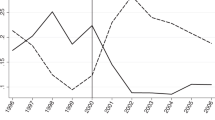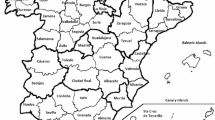Abstract
The effect of international marriage - a union between a country native and an immigrant - on social and family outcomes is endogenous due to the selection into marriage markets and non-random spousal choice. In this paper we use availability of cheap airline flights as region-specific instrumental variable that increased the probability of intermarriage in Europe. The two-stage least squares analysis applied to 1977–2006 IPUMS International Project Census micro data shows no significant difference in the family size or number of children between intermarried and same-nativity couples. However, it does reveal higher labor force participation rates and much lower marriage rates among mixed nationality couples.


Similar content being viewed by others
Notes
OECD Country Statistical Profiles (http://stats.oecd.org/).
UN Population Division, Trends in International Migrant Stock: The 2013 Revision, September 2013.
United Nations, Department of Economic and Social Affairs (2013). Trends in International Migrant Stock: The 2013 revision (United Nations database, POP/dB/MIG/Stock/Rev.2013).
We also considered other instrumental variables that are specific to the European region, such as European Union (EU) membership, the Schengen travel agreement and the introduction of the Euro, and the results remain similar to those obtained here.
Minnesota Population Center. Integrated Public Use Microdata Series, International: Version 6.3 [Machine-readable database]. Minneapolis: University of Minnesota, 2014. (https://international.ipums.org/international/)
Data on the European Union and Eurozone membership status for the countries in my sample was collected from the official website of the European Union (http://europa.eu/).
Data on cheap flight routes following the deregulation was collected on airline and travel websites, primarily https://www.ryanair.com/us/en/ , http://www.easyjet.com/en , https://www.ricksteves.com/travel-tips/transportation/budget-flights .
Control function (CF) is a method of dealing with endogenous independent variables, see Wooldridge (2015).
In OECD-25 countries, between 2006 and 2011, 6.8% of the population age 20 and over are cohabiting, versus 49.9% who are married and 15.2% that are single. (OECD Family Database, SF3.3: Cohabitation rate and prevalence of other forms of partnership)
References
Angrist J (2002) How do sex ratios affect marriage and labor markets? Evidence from America’s second generation. Q J Econ 117(3):997–1038
Basu S (2015) Intermarriage and the labor market outcomes of Asian women. Econ Inq 53(4):1718–1734
Becker G (1974) A Theory of Marriage. In Economics of the Family: Marriage, Children, and Human Capital, ed. TW Schultz, Chicago: Univ. Chicago Press: 299-344
Bleakley H, Chin A (2010) Age at arrival, English proficiency, and social assimilation among US immigrants. American Economic Journal: Applied Economics 2(1):165–192
Esteve, A., J. Garcia and R. McCaa (2011) Comparative perspectives on marriage and international migration, 1970-2000: findings from IPUMS-international census Microdata samples. In Seminar on global perspectives on marriage and international migration, 20–21
Greenwood J, Guner N, Kocharkov G, Santos C (2014) Marry Your Like: Assortative Mating and Income Inequality. Am Econ Rev 104(5):348-353
Gubernskaya Z (2010) Changing attitudes toward marriage and children in six countries. Sociol Perspect 53(2):179–200
Lanzieri, G. (2012) Mixed Marriages in Europe, 1990–2010. In Cross-Border Marriage: Global Trends and Diversity, 81–121. Korea Institute for Health and Social Affairs (KIHASA)
Levchenko P, Solheim C (2013) International marriages between eastern European-born women and U.S.-born men. Fam Relat 62(1):30–41
Meng X, Gregory R (2005) Intermarriage and the economic assimilation of immigrants. J Labor Econ 23(1):135–174
Nielsen H, Smith N, Çelikaksoy A (2009) The effect of marriage on education of immigrants: evidence from a policy reform restricting marriage migration. Scand J Econ 111(3):457–486
Nottmeyer O (2014) Relative labor supply in intermarriage. IZA Journal of Migration 3:3
Qian Z, Lichter D (2001) Measuring marital assimilation: intermarriage among natives and immigrants. Soc Sci Res 30:289–312
Terza J, Basu A, Rathouz P (2008) Two-stage residual inclusion estimation: addressing endogeneity in health econometric modeling. J Health Econ 27(3):531–543
Wooldridge J (2015) Control function methods in applied econometrics. J Hum Resour 50(2):420–445
Acknowledgments
We are grateful to Thomas Hyclak and Mengcen Qian, as well as Keshar Ghimire, the participants of 41st Eastern Economic Association Meeting and Lehigh University Economics Seminars for their insightful comments.
Author information
Authors and Affiliations
Corresponding author
Ethics declarations
Conflict of Interest
There are no potential conflicts of interest. All mistakes are our own.
Rights and permissions
About this article
Cite this article
Ponomareva, E., Chou, SY. & Nikolsko-Rzhevskyy, A. Social and Economic Impacts of International Marriages in Europe. J Labor Res 39, 259–276 (2018). https://doi.org/10.1007/s12122-018-9267-x
Published:
Issue Date:
DOI: https://doi.org/10.1007/s12122-018-9267-x




